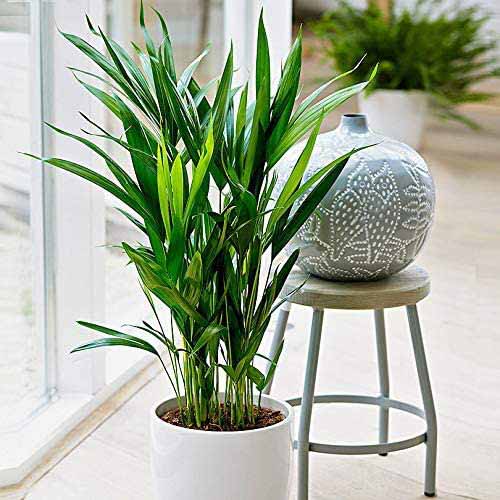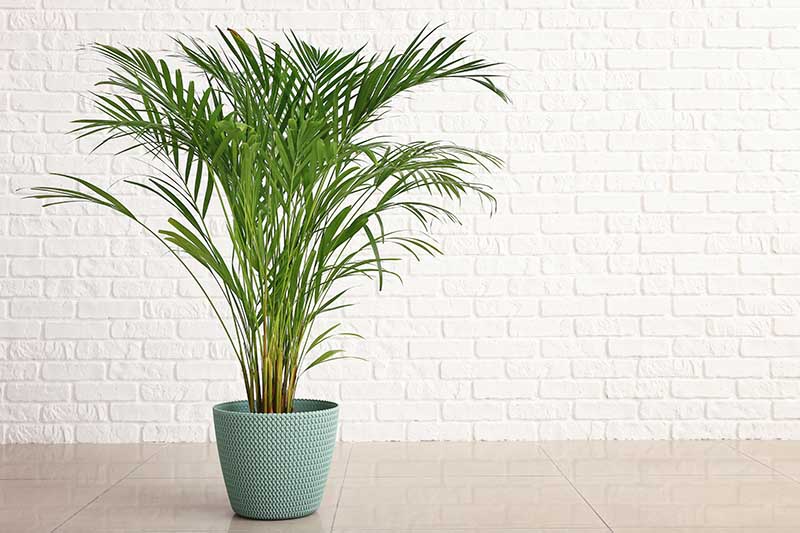Areca palm is the best palm species for bright indoor décor. Thanks to its feathery and arching fronds with up to 100 leaflets each. The lush foliages and golden trunks help to bring a tropical feeling to a home.
Areca palm care involves the provision of bright indirect sunlight, regular watering, well-draining potting soil, high humidity, and a temperature range of 60-75oF (16-24oC). Use liquid fertilizer to feed the palm tree every month during spring and summer.
Indoor growing environments tend to differ from the palm’s natural habitat. The dynamics increase the risk of killing the palm tree at home. Continue reading this guide to learn how to grow and care for areca palm at home.
You May Also Read: How to Care for Blue Star Fern

What Does Areca Palm Looks Like?
Areca palm is also known as butterfly palm or golden cane palm. The palm has smooth or golden trunks that resemble bamboo clumps. The fronds are narrow and full like bamboo leaves.
The lush foliages make this palm species ideal for bright interiors and the purification of air. It is the reason behind their popularity in offices and shopping malls.
A full-grown areca palm tree is quite expensive due to its attraction, and it is suitable as a tabletop plant. It can reach 6-7 ft at maturity.
Areca palm can tolerate trimming without becoming fussy and live up to 10 years. But the indoor areca palm experience a slow to the moderate growth rate.
According to ASPCA, areca palms are non-toxic to cats and dogs. But I do recommend keeping your houseplant away from pets and toddlers to avoid destruction.
Areca Palm Care Details
| Origin | Madagascar Island |
| Scientific Name | Dypsis lutescens |
| Common Names | Areca palm Butterfly palm Golden cane palm Yellow palm Bamboo palm |
| Maximum Growth (approx.) | 6-8ft indoor |
| Light Requirements | Bright indirect sunlight. |
| Watering Needs | Consistent soil moisture without becoming soggy. A damp condition causes root rot. |
| Temperature Range | 65-75oF (16-24oC). |
| Humidity Requirement | Medium to high humidity. I recommend humidity above 50%. |
| Soil Requirements | Well-draining soil with a pH range of 6.1 to 6.5 |
| Fertilizer Application | Feed the palm every month during spring and summer with liquid fertilizer. |
| Bloom | Pale yellow flowers in summer |
| Propagation | Root division and seeds |
| Repotting | Once every 3-4 years |
| Pests and Diseases | Pests: Scales, mealybugs, red spider mites, and whiteflies. Diseases: Pink rot due to overwatering. |
| Toxicity | Non-toxic to pets and humans |
How to Care for Areca Palm
Areca Palm Soil Requirements
The golden cane palm does best in well-draining soil with a pH range of 6.1 to 6.5. The potting soil should also have the ability to hold moisture.
Heavyweight and compact soil prevent root aeration. The soil structure also increases the risk of root rot after watering. Every houseplant enthusiast needs to be selective when it comes to soil.
I recommend a mixture of peat moss, potting soil, and perlite. The peat moss holds moisture, and perlite facilitates water drainage. Add compost to improve soil fertility.
Areca Palm Sunlight Requirements
The butterfly palm thrives under bright indirect sunlight. The best location is either a west or south-facing window where the palm will get sufficient light.
Direct sunlight exposure will scorch the fronds and ruin their beautiful appearance. Low-light conditions make the palm leaves turn yellowish-green.
Areca palm is not a low-light houseplant. Relocate the bamboo palm to a room that receives bright indirect sunlight. Take the time to read my article on the Best Low Light Houseplants.
Areca Palm Watering Frequency
The golden cane palm prefers slightly moist soil to thrive well. Too much soil moisture increases the risk of root rot or pink rot.
Water the areca palm more often during spring and winter than fall and winter. The golden rule is to inspect the soil moisture content level before watering the plant.
I recommend the use of terracotta pots (Check Best Deals on Amazon) since it allows moisture to evaporate faster. Use distilled water or rainwater since the palm is sensitive to chemicals.
Areca Palm Temperature Range
The butterfly palm is a tropical palm tree that thrives a room temperature. The best temperature range to consider at home is 65-75oF (16-24oC).
The room temperature makes this indoor palm feel comfortable and stays happy. Hot and cold drafts might harm your palm tree at home.
I prefer keeping this yellow cane palm away from air vents, open windows, and radiators. The purpose is to keep the lush foliages vibrant.
Areca Palm Humidity Level
A bamboo palm flourishes in a warm and humid environment. But it can be challenging when growing a golden cane palm indoors.
High humidity is essential for keeping the areca palm healthy and happy. Use a digital hygrometer to help in monitoring indoor humidity changes.
I recommend installing a room humidifier to maintain the ideal moisture level for your favorite houseplant. Another excellent option is to mist the palm leaves more often to boost humidity.
Areca Palm Fertilizer
Butterfly palms are not heavy feeders like other indoor palm trees. Fertilizer nutrients and minerals help to foster vegetative growth.
Use a dilute palm fertilizer or houseplant fertilizer to feed the palm every month during spring and summer. The nutrients and minerals will help to prevent yellow leaves.
Too much feeding will result in the build of mineral salts that can ruin your palm tree. Avoid feeding the butterfly palm in winter due to dormancy.
Besides that, the excess mineral salts could be the reason behind the brown leaf tips. I recommend flushing the soil with distilled water for a couple of months.
Remember to use fertilizer rich in magnesium, potassium, and iron. Another option is to use homemade fertilizer for houseplants. Here is the guide on how to make homemade fertilizer.
Pruning and Maintenance
Butterfly palms require minimal pruning routines. Removing some fronds help all the leaves to get adequate sunlight. The good news is that the areca palm is not sensitive to pruning.
Pruning helps mature palms to have a lifespan of 10years. I recommend snipping the brown leaf tips since it may make the entire frond die.
Trimming old or dead fronds help to redirect energy to growing parts. Besides that, it helps to golden cane palm to mark a lasting impression.
Areca Palm Propagation
Areca palm is a slow-growing tropical palm that grows from the base clusters of offshoots or canes. These offshoots make areca propagation looks easier.
Use a sharp blade to remove offshoot with some roots from the parent plant. Place the roots in water for an hour and transfer them to the pot.
Seeds are other options for areca palm propagation. Plant the seeds in potting soil and wrap them with plastic. Puncture holes on the plastic to increase ventilation and keep the soil moist.
Propagating areca palms via seeds is challenging to get a new plant. I recommend the offshoot division since new plants occur faster.
How to Repot Areca Palm
The golden cane palm is less vulnerable to pot-bound issues. It makes the palm require a minimal transplant to resolve the root-bound problem.
I recommend re-potting this palm every three to four years if there are signs of pot-bound. Use a slightly bigger pot for tight-fitting its roots and reduce the risk of overwatering.
A bamboo palm struggling with root-bound issue display stunted growth and yellow leaves. Be sure to re-pot the palm tree during springtime. Use fertile and well-draining potting soil.
Common Problems and Solutions
Pests
Areca palm can easily die due to pest infestations. These sap-sucking insects attack a palm grown in a poorly ventilated room receiving low natural light.
Red spider mites, scales, mealybugs, and whiteflies are the common pests attacking the golden cane palm. Investigate your palm to identify the exact insects attacking it.
Use organic neem oil solution or insecticidal soap to eliminate the pests from the indoor palm. Be sure to spray the golden cane palm twice a day to kill all the pests on the houseplant.
Diseases
Overwatering is the leading cause of root rot or pink rot among areca palms. It occurs due to poor soil drainage and a lack of drainage holes at the bottom of the pot.
Use well-draining soil and a pot with drainage holes at the bottom to avoid sogginess. Well-draining soil guarantees proper root aeration and water drainage.
The drainage holes help to get rid of excess water from the pot. Be sure to check the soil moisture content before watering the golden cane palm.
Frequently Asked Questions
Is Areca Palm Toxic to Pets and Humans?
No. The butterfly palm is safe for cats, dogs, and toddlers. But I recommend keeping the houseplant away from pets and children to avoid destruction.
Why Are My Areca Palm Leaves Turning Yellow?
Yellow leaves on the areca palm are due to improper watering routine. Too much or too little water is the reason behind the areca palm leaves turning yellow.
Check the soil moisture content more often and soak it with water when dry. Slightly moist potting soil will help to revive the golden cane palm. Remember to boost the humidity.
Why Do My Areca Palm Leaves Have Brown Spots?
Brown spots on areca palm leaves occur due to mineralized water. Tap water contains fluorides and chlorine that cause brown spots on leaves. Use distilled water instead of tap water.
Brown leaves and brown spots can also be due to over-fertilization. Flush the soil and reduce the feeding frequency to revive the houseplant.
Why Do My Areca Palm Leaves Have Brown Tips?
Brown tips on areca palm leaves occur due to cold and hot drafts. Low indoor humidity is the sole cause of the brown leaf tips and edges.
Use a humidifier to increase the indoor humidity and curb the brown leaf tips formation. Misting the leaves is another excellent option for boosting air moisture around the plant.

Conclusion
Areca palms bring a touch of a tropical paradise into the living space or office. The graceful fronds will make you have the gulf feeling beach.
Areca palm care consists of bright indirect sunlight, high humidity, regular watering, and a temperature range of 65-75oF. Feed the houseplant every month during spring and summer.
The golden cane palm can be propagated through seeds and division. The separation method is more reliable and effective than seeds.
